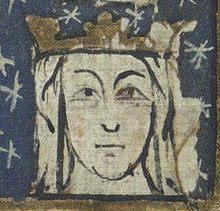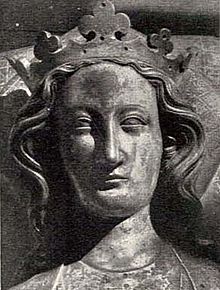Eleanor of Castile (1241-1290)
Eleanor of Castile (also Leonor or Eleanor ) (* 1241 ; † November 28, 1290 in Harby , Nottinghamshire ) was the first wife of the English King Edward I Royal Consort of England.
origin
Eleonore was born in Castile as the second child of King Ferdinand III. and his second wife Johanna , the heiress of the French county of Ponthieu . Her older brother Ferdinand was born in 1239/40, her younger brother Luis in 1242/43. On the first anniversary of her death in 1291, 49 candle carriers appeared, each candle for a year of life, so that she was probably born in 1241.
Marriage to the English heir to the throne
On November 1, 1254, Leonore was married to the English heir to the throne, Lord Edward , in the Las Huelgas monastery near Burgos . Her half-brother Alfonso X transferred the old Castilian claims to Gascogne, which belonged to the English kings, to his new brother-in-law . As late as 1253, there had been a conflict between England and Castile in the south-west of France because of these claims. The marriage between the Castilian princess and the English heir to the throne had been agreed upon during the subsequent peace negotiations. At the end of November 1254, Eleanor traveled with her husband to Gascony, where he remained as his father's governor until the next summer. In October 1255 the couple finally reached England.
Role in the war of the barons
When there was a crisis between her father-in-law Heinrich III. and a nobility opposition came, Eleanor supported her husband, who sided with his uncles from France, the Lusignans. These were hated by the English barons because of their influence and privileges and had to leave England in July 1258. After the aristocratic opposition had seized power in England, Eleanor accompanied her husband, who was mainly in France and Gascony from 1260 to 1263. It was not until February 1263 that they returned to England with mercenaries who had been recruited with Eleonore's funds in Ponthieu to support King Henry. During the riots of 1263 and the ensuing open war between the barons and the king, Eleanor stayed mainly at Windsor Castle . After the battle of Lewes in June 1264, in which Simon de Montfort , the leader of the aristocratic opposition, had regained power, she stayed in the wake of the largely disempowered King Heinrich, while her husband, who had come under the control of the barons, was held in other castles has been. Montfort feared that Eleanor would recruit mercenaries from Castile or France again and therefore had them monitored. After the victory of the royal party in the Battle of Evesham in August 1265, in which Montfort was killed, they secured numerous lands at the expense of the expropriated rebels. In doing so, she created the basis for her own property, which she later expanded considerably.
Crusade to Palestine
In August 1270 she accompanied Eduard on his crusade to the Holy Land . There Eduard was injured by an assassin with a poisoned dagger in June 1272 and could only be saved by the intervention of a surgeon who cut the poisoned flesh from his arm. According to legend, Eleanor is said to have sucked the poison out of the wound, but this was only reported by an Italian Dominican after her death . In England this was first published in 1586. A contemporary chronicler of the Crusade, however, reports that the desperate Eleanor had to be led away from her husband's bed before the operation.
Royal Consort of England
King Henry died while they were in Palestine in November 1272. Her husband inherited the throne, but after their return from Palestine, Edward and Eleanor first visited France and Gascony before returning to England in August 1274. On August 19, she and her husband were crowned at Westminster Abbey . From 1275, with the support of the king, she expanded her property by guaranteeing the debts that numerous knights and barons owed to Jewish moneylenders. In return, she received the land pledged as security. In this way, she acquired a large property by 1281, which she expanded in the following years through the direct purchase of indebted goods. Her hunger for land and the exorbitant interest which she demanded from the knights who were in debt to her and which ultimately led to the transfer of the lands were soon notorious and the subject of numerous rumors and ridiculous verses. In 1283 Archbishop Pecham warned the Queen that her actions could cause scandal, and in 1286 he warned her of the public outrage over her greed and the rumors that were being told about her. At the time of her death, she had earned over £ 2,500 a year from her property, which was unprecedented for an English queen. The king wanted to take action against accusations against his deceased wife when she died, because he believed her to be wrong, in doing so he had to find out how ruthless Eleonore's officials were towards their tenants and debtors and how unscrupulous she had acted against opponents herself.
Although the marriage was diplomatically advantageous for the heir to the throne, it was unpopular from the start, as it was feared that, similar to Edward's mother Eleanor of Provence and the Lusignan half-brothers of King Henry III. , numerous foreign relatives and favorites would come to England with the Castilian princess. In fact, she brokered marriages with English partners for several of her relatives, but proceeded so discreetly that she did not arouse open criticism. Their preference for Castilian merchants, however, caused displeasure among the merchants from Southampton . The queen herself was considered highly cultured. She promoted English poets, but also the universities that were being trained. She founded several branches of the Dominican Order , this and her business relationships with Jewish moneylenders led to growing rejection by the English bishops and the monastic orders. Her husband respected her, but did not allow her direct political influence. Since he was heavily in debt due to his numerous wars, he extorted part of her property from her. Her attempt to improve relations between her native Castile and England was not effectively supported by her brother Alfonso X. After the death of her mother, she inherited the French Ponthieu in 1279, which she managed through representatives. Their political influence remained insignificant overall.
When she and her husband visited Gascony again in 1287, she fell ill with a fever, which probably also led to her death three years later. She died at Richard de Weston's home in Harby, Nottinghamshire. Her body was first embalmed in Lincoln and transferred to Westminster , where it was buried in an elaborate funeral on December 17th at Westminster Abbey. Her entrails were buried in Lincoln Cathedral and her heart in the Dominican Church in London. Her bronze grave memorial made by William Torel is preserved in Westminster Abbey .
Aftermath
Eduard had twelve monumental high crosses , the so-called Eleanor crosses, erected along the route that their funeral procession made from Lincoln to Westminster , of which the crosses in Geddington , Hardingstone and Waltham have been preserved.
During her lifetime Eleanor was controversial, if not unpopular, among large sections of the population because of her foreign origin, her land acquisition, her usury and even because of her good relationship with her husband. In the Chronicle Historia Anglicana , written more than 100 years after her death, however, she was positively represented by Thomas Walsingham . This contributed to the fact that she was more respected in the centuries after her death than in her lifetime.

ancestors
| Ferdinand II of León | Dona Urraca of Portugal | Alfonso VIII of Castile | Eleanor Plantagenet | Aubry II of Dammartin | Mathilde de Clermont | Wilhelm II. Talvas | Alix of France | ||||||||||||||||||||||||||||||||||||||||||||||||||||||
| Alfonso IX from León | Berenguela of Castile | Simon von Dammartin | Mary of Ponthieu | ||||||||||||||||||||||||||||||||||||||||||||||||||||||||||
| Ferdinand II of Castile / III. from Spain | Johanna von Dammartin | ||||||||||||||||||||||||||||||||||||||||||||||||||||||||||||
| Eleanor of Castile | |||||||||||||||||||||||||||||||||||||||||||||||||||||||||||||
Family and offspring
She was a faithful wife to her husband, with whom she had a total of 16 children, including:
- a stillborn daughter (* May 1255 in Bordeaux )
- Katherine (June 17, 1264 - September 5, 1264), buried in Westminster Abbey .
- Johanna (January 1265, † before September 7, 1265), buried in Westminster Abbey
- Johann (born July 13, 1266, † August 3, 1271 in Wallingfort) was buried in Westminster Abbey under the supervision of his great-uncle Richard, Earl of Cornwall
- Heinrich (* before May 6, 1268; † October 16, 1274)
- Eleonore (* June 18, 1269; † October 12, 1297 or † August 29, 1298); ⚭ Count Heinrich III. from bar
- Daughter (* May 1271 in Palestine , † before September 1271)
- Joan of Acre (1272 - April 7, 1307); ⚭ I. Gilbert de Clare, 6th Earl of Hertford and ⚭ II. Ralph de Monthermer, 1st Baron Monthermer
- Alphonso, Earl of Chester (November 24, 1273 - August 19, 1284), buried in Westminster Abbey
- Margaret (born March 15, 1275, † after 1333); ⚭ John II of Brabant .
- Berengaria (May 1, 1276 - before June 27, 1278), buried in Westminster Abbey.
- Daughter who died shortly after birth in January 1278.
- Mary (March 1278; † around 1332), nun in Amesbury Abbey , Wiltshire
- Elisabeth von Rhuddlan (born August 1281 in Rhuddlan, † May 5, 1316); ⚭ I John I , Earl of Holland and ⚭ II. Humphrey de Bohun, 4th Earl of Hereford , 3rd Earl of Essex ( House Bohun )
- Edward of Caernarvon (Eduard II.) (Born April 25, 1284 in Caernarvon, † September 21, 1327); ⚭ Isabella of France
As was often the case with the nobility in the Middle Ages, she and her husband paid little attention to the children. Her daughter Johanna, for example, grew up mostly with her grandmother in Ponthieu, and when her son Heinrich was dying in Guildford, the parents made no effort to come from London to see him again. When her children died, one son and five daughters were still alive. It was not until nine years after her death that her husband married Margaret of France for a second time in 1299 .
literature
- John Carmi Parsons: Eleanor of Castile. Palgrave, 1997, ISBN 0-312-17297-4 . (English)
- Carsten Dilba: Memoria Reginae - The memorial program for Eleanor of Castile. Olms, 2009, ISBN 978-3-487-13943-2 .
Web links
- John Carmi Parsons: Eleanor (1241-1290). In: Henry Colin Gray Matthew, Brian Harrison (Eds.): Oxford Dictionary of National Biography , from the earliest times to the year 2000 (ODNB). Oxford University Press, Oxford 2004, ISBN 0-19-861411-X , ( oxforddnb.com license required ), as of 2004
Individual evidence
- ^ John Carmi Parsons: Eleanor of Castile , 1997, p. 58
- ↑ John Carmi Parsons: Eleanor (1241-1290). In: Henry Colin Gray Matthew, Brian Harrison (Eds.): Oxford Dictionary of National Biography , from the earliest times to the year 2000 (ODNB). Oxford University Press, Oxford 2004, ISBN 0-19-861411-X , ( oxforddnb.com license required ), as of 2004
| predecessor | Office | Successor |
|---|---|---|
| Eleanor of Provence |
Queen Consort of England 1274–1290 |
Margaret of France |
| personal data | |
|---|---|
| SURNAME | Eleanor of Castile |
| BRIEF DESCRIPTION | first wife of Edward I of England |
| DATE OF BIRTH | 1241 |
| DATE OF DEATH | November 28, 1290 |
| Place of death | Harby , Nottinghamshire |


